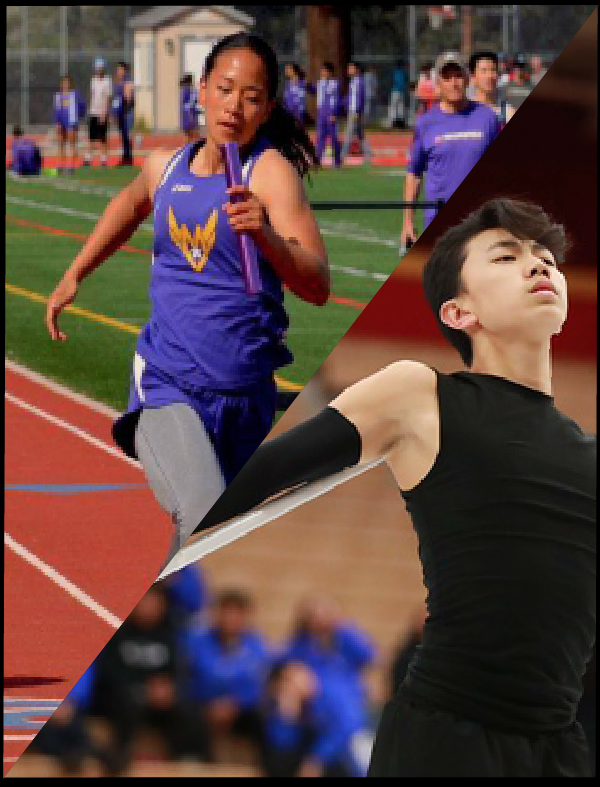Conflicting Commitment
For some MVHS athletes, conflicting seasons means choosing one sport over another.
April 12, 2019
For sophomore Henry Zhai, the summer before his freshman year was filled with going back and forth between practices. He played the summer season for his club volleyball team while also attending the MVHS color guard team’s summer workshop. It was only after summer ended and school began that he realized he had to make a tough choice between the two sports.
Although he had already made the decision to stop playing club volleyball, Zhai also chose not to try out for the MVHS volleyball team, despite the fact that he had played for his middle school team for three years. As a year-round commitment, color guard practice never stopped and often coincided with volleyball games or practices. As it became evident to him that balancing the two would be impossible, Zhai chose to drop volleyball in order to continue with color guard, which he thought he would be better at.
“I just thought about it for a while and then I realized … well volleyball — yes it’s really fun and I’ve been playing it for a couple of years, but I thought that I’m more naturally skilled in color guard in my opinion and for volleyball, it’s kind of hard for me to play in the future,” Zhai said.
Just like he used to play both club and school volleyball, Zhai’s commitment to color guard extends to outside of being part of the school guard as well. Zhai is part of Drum Corps, which he describes as a “high level marching band and color guard.” Because of Drum Corps, if he chooses to, Zhai can continue to participate in color guard after high school, perhaps even after college, something that he considered before choosing to continue with color guard.
Senior Kaitlyn Zou faced the same conflict when she had to choose between track and field and softball — two sports she had been involved in and both of which took place in spring season. During her sophomore year, Zou attempted to do both, starting out with track and also joining a few softball practices. Although she had played softball since third grade, only taking a break from the sport in middle school, she chose to continue with track and field for the year.
“The [softball] team dynamic and the attitude towards the sport was just really different from football and the other sports I did,” Zou said. “It wasn’t as disciplined. It was kind of you do whatever you want and there was a lot more joking around, so then I went back to track because you need a lot more discipline.”
In junior year Zou chose to come back to softball, because her football coach also coached softball. According to Zou, her coach told her that if she played softball for him, he would run through agility drills for football after practice. For her, this made the difficult decision of choosing between the two sports much easier. While the promise of improving in football through more time with her coach is what drew her back to softball, Zou explains that participating in track and field also helped with her other commitments.
“Definitely for track, it was just a lot of conditioning that kind of carried over into football season,” Zou said. “It definitely helped me keep in shape.”
As many track and field athletes play multiple sports, some of them coinciding in the same season, track and field coach Kirk Flatow has often worked with students and other coaches to resolve issues and help the athlete continue to participate in multiple sports. He says communication is the most important factor when trying to balance two sports in the same season. While the time commitment it takes to participate in two sports simultaneously isn’t something everyone is able to do, Flatow tries to be as accommodating as possible when students want to play another sport while also doing track and field. Flatow believes that participating in a sport like track and field can greatly improve an athlete’s abilities in their other sports.
“[Track and field] is about being athletic,” Flatow said. “Being fast, being agile, being able to jump, being strong. And that is useful in any other sport you can name.”
He cites athletes like San Francisco 49ers defensive back Richard Sherman, who was a triple jumper for Stanford while also playing football for the school, along with 2018 alumna Nanda Nayak. Nayak, a soccer player, joined track for the first time her senior year, ending the season as a CCS champion, and shaving a second off of her 100 meter, which also helped her on the soccer field.
“That happens all the time. Yet, for some reason kids think, ‘Oh well, I’ve got to focus on my sport,’” Flatow said. “They don’t realize trying something new, like joining track and field, can actually help them do that.”
Although both him and Zou find value in playing multiple sports, Flatow cautions against trying to take on too much. For him, students who attempt to to participate in two sports, especially during the same season must be able to balance their time and communicate well.
“It depends a lot on the person,” Flatow said. “They have to be really responsible about communicating between their coaches [and they] have to want to [play both sports].”



















